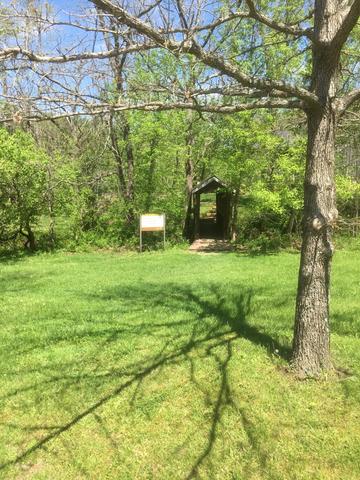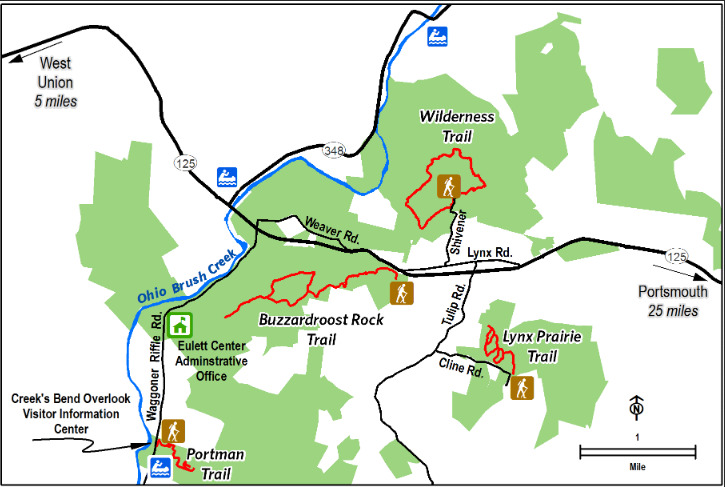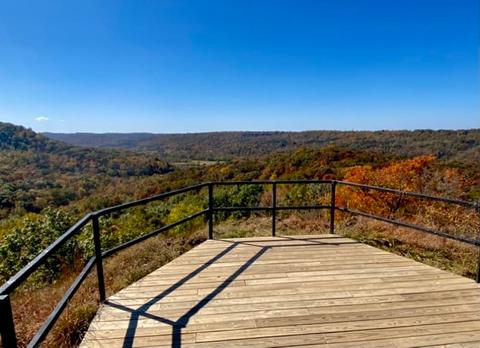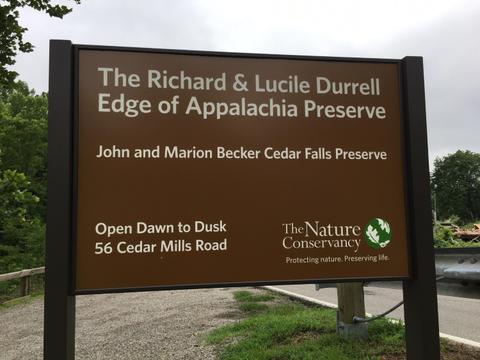
Edge of Appalachia Preserve
Edge of Appalachia Preserve
The Nature Conservancy West Union, Ohio 45693
Official WebsiteEdge of Appalachia Preserve (Cincinnati Museum Center) website
Edge of Appalachia video
Edge of Appalachia Preserve Trail Locations map
Tips for Birding
Birding at the Edge and the surrounding area can be very rewarding for Ohio birders. Here at the states’ southern border, vast wooded tracts, varied edges, grasslands and old fields make a medley of habitats available to breeding and migrating birds. 172 species of birds have been recorded on the preserve. 107 breed here, and 11 are of high conservation concern. Many Ohio birders come to the preserve, and elsewhere in Adams County, to find the first arriving species each year, or those species found in few other places in the state.
From Cincinnati: Take OH-32 east to OH-247 south to West Union. Allow 1.5 to 2 hours driving time.
From Dayton: Take I-75 south to I-275 east. Then follow OH-32 east to OH-247 south toward West Union. Allow 2 to 2.5 hours driving time.
From Columbus: Take OH-23 south to OH-32 west. Then follow OH-41 south to West Union. Allow 2.5 hours driving time.
Open all year during daylight hours.
Parking areas: At the Lynx Church, the Buzzard Roost Rock parking area on Weaver Road, and the Wilderness Preserve parking area on Shivener Road.
Birds of Interest
Winter
All of the expected winter sparrows and finches can be found here, in varying numbers, each year. An occasional Bald Eagle is reported from down near the Ohio River about every year now. You never know what will show up on the Christmas Bird Count.
Spring
Nearly all eastern warblers have been recorded on the Edge at one time or another. One day in 1998, 32 species of warblers were seen here. There is usually not much here in the way of waterfowl. All of the expected buteos, accipiters, American Kestrel and Great-horned, Barred and Screech Owls are found here in good numbers. Waterthrushes are usually the first warblers to arrive, followed closely by Black-and-white and Prairie Warblers.
Summer
Unusual Ohio breeding birds that one might expect to find on the Edge are: Black Vulture, Chuck-will’s-widow, Yellow-throated Warbler, Pine Warbler, Prairie Warbler Cerulean Warbler, Prothonotary Warbler, Worm-eating Warbler, Hooded Warbler, Yellow-breasted Chat, Ruffed Grouse, Wild Turkey, Blue Grosbeak, Savannah Sparrow, Grasshopper Sparrow, Henslow’s Sparrow and, if you are very lucky, perhaps a Bewick’s Wren.
Fall
Many fall warblers come through on their way back south. This is a difficult time of the year to bird here, as it gets very quiet.
About this Location
This 20,000-acre preserve system is referred to as “The Edge.” Each separate preserve and trail offers unique qualities. Visitors will enjoy gorgeous views, distinctive geology, and peaceful trails. It is also a great place for birding, especially in spring and fall. Activities include hiking, birding, fishing, kayaking/canoeing, wildlife-watching, nature photography, and observing native plants.
Ancient forests of massive oaks and American chestnut once blanketed nearly all of what would become southern and eastern Ohio. When the first white settlers arrived in the Ohio Valley, wolves and elk wandered this rustic landscape of pristine rivers and fertile forests.
Yet by the early 1900s, about 90 percent of the original forest cover had been cleared to make room for farmland and to feed the iron furnaces of southern Ohio – severely degrading part of North America’s oldest and most biologically diverse forest systems.
Today, Ohio’s Appalachian forests are returning, with nearly 40 percent of the region cloaked in mixed hardwood forest. The Nature Conservancy’s 20,000-acre Edge of Appalachia Preserve is a key component of this recovery process, mending habitats on a large scale and preserving the landscape’s unique natural legacy.
Content from Official Website and Ohio Ornithological Society





